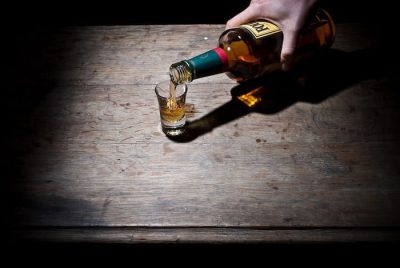One question often comes up when discussing a fifth of whiskey is how many shots in a fifth of whiskey? The answer to this question is not straightforward, as the number of shots in a fifth of whiskey will depend on the size of the shot glass you are using.
A common size for a shot glass is 1.5 fluid ounces, and using this size as a reference, and you can expect to get around 16.7 shots from a fifth of whiskey. However, it is important to note that shot glass sizes can vary, and you may get more or fewer shots depending on the size of your shot glass.
Also, if you are using a larger shot glass that holds 2 fluid ounces, you can expect to get around 12.8 shots from a fifth of whiskey. On the other hand, if you are using a smaller shot glass that holds 1 fluid ounce, you can expect to get around 25.6 shots from a fifth of whiskey.
Ultimately, the number of shots you can get from a fifth of whiskey will depend on the size of your shot glass and your personal preference.
What is a fifth of whiskey?
A fifth of whiskey is a unit of volume that is commonly used to purchase and consume whiskey. It is equal to 25.6 fluid ounces, or approximately 750 milliliters. A fifth of whiskey is a popular size for purchasing whiskey because it is a convenient and portable size that is easy to transport and store.
Also a fifth of whiskey is also commonly used as a reference point when discussing the amount of whiskey in a particular bottle or container.
For example, you may hear someone say that a particular bottle contains “a fifth of whiskey” to indicate that it contains 25.6 fluid ounces of whiskey.
In addition, a fifth of whiskey is a widely recognized and widely used unit of volume for purchasing and consuming whiskey. It is a convenient and portable size that is ideal for those who want to try out different types and brands of whiskey or who want to enjoy a moderate amount of whiskey on a regular basis.
The history of the fifth as a unit of measurement for alcohol
A fifth is a unit of measurement for alcoholic beverages that is equal to one-fifth of a gallon, or approximately 750 milliliters. This unit is commonly used for packaging and selling distilled spirits such as whiskey, vodka, and gin.
The origin of the fifth as a unit of measurement for alcohol is unclear, but it is believed to have originated in the United States in the early 20th century. The fifth was likely chosen as a convenient size for consumers and as a way for producers to package and sell their products.
Prior to the adoption of the fifth, other units of measurement were commonly used for alcohol, including the gallon, quart, and pint. The use of the fifth as a standard unit of measurement has since spread to other countries, although it is not used universally and other units of measurement are also in use.
It’s worth noting that the size of a fifth has varied over time. In the United States, the size of a fifth was originally defined as equal to one-fifth of a gallon, which is approximately 757 milliliters. However, the size of a fifth was later redefined by the Alcohol and Tobacco Tax and Trade Bureau (TTB) as equal to 750 milliliters, which is the size that is most commonly used today.
How to measure and mix cocktails using a fifth of whiskey
To measure and mix cocktails using a fifth of whiskey, you will need a cocktail shaker and a jigger or measuring cups to measure out your ingredients.
Here are some general guidelines for mixing cocktails using a fifth of whiskey:
1. Start by selecting a recipe for the cocktail you want to make. Make sure you have all of the necessary ingredients on hand.
2. Measure out the ingredients using a jigger or measuring cups. A jigger is a small, hourglass-shaped measuring device with two sides of different sizes that is commonly used in the bartending industry. If you don’t have a jigger, you can use measuring cups to measure out your ingredients.
3. Add the ingredients to a cocktail shaker. A cocktail shaker is a metal or glass container with a tight-fitting lid that is used to mix cocktails by shaking them.
4. Shake the cocktail shaker to mix the ingredients. Make sure to shake the shaker vigorously to ensure that the ingredients are well-mixed.
5. Strain the cocktail into a glass. Use a strainer to pour the cocktail into a glass, leaving any ice or other solids behind.
6. Garnish the cocktail as desired and serve. You can garnish your cocktail with a twist of lemon, a cherry, or a sprig of mint, depending on the recipe and your personal preference.
It’s important to note that the exact measurements for mixing cocktails can vary depending on the recipe and personal preference. Some recipes may call for specific measurements, while others may be more flexible and allow you to adjust the amounts to taste. It’s a good idea to start with smaller amounts and add more as needed to achieve the desired balance of flavors.
The most popular cocktails made with a fifth of whiskey
There are many popular cocktails that can be made using a fifth of whiskey. Here are a few examples:
1. Old Fashioned
This classic cocktail is made with whiskey, sugar, bitters, and a twist of orange peel. To make an Old Fashioned, combine 2 ounces of whiskey, 1 sugar cube (or 1/2 teaspoon of simple syrup), and a few dashes of bitters in a mixing glass. Add ice and stir until the sugar is dissolved. Strain the mixture into a glass with a large ice cube and garnish with a twist of orange peel.
2. Whiskey Sour
This classic cocktail is made with whiskey, lemon juice, and simple syrup. To make a Whiskey Sour, combine 2 ounces of whiskey, 1 ounce of lemon juice, and 1 ounce of simple syrup in a cocktail shaker. Add ice and shake until well combined. Strain the mixture into a glass and garnish with a cherry and a twist of lemon.
3. Manhattan
This classic cocktail is made with whiskey, sweet vermouth, and bitters. To make a Manhattan, combine 2 ounces of whiskey, 1 ounce of sweet vermouth, and a few dashes of bitters in a mixing glass. Add ice and stir until well combined. Strain the mixture into a glass and garnish with a cherry.
4. Sazerac
This classic New Orleans cocktail is made with whiskey, absinthe, and a variety of bitters. To make a Sazerac, coat the inside of a glass with absinthe and set it aside.
In a separate mixing glass, combine 2 ounces of whiskey, 1 sugar cube (or 1/2 teaspoon of simple syrup), and a few dashes of bitters. Add ice and stir until the sugar is dissolved. Strain the mixture into the absinthe-coated glass and garnish with a twist of lemon.
5. Irish Coffee
This classic cocktail is made with whiskey, coffee, sugar, and whipped cream. To make an Irish Coffee, combine 2 ounces of whiskey, 6 ounces of hot coffee, 1 teaspoon of sugar, and a dollop of whipped cream in a glass. Stir until the sugar is dissolved and the whipped cream is incorporated.
These are just a few examples of the many cocktails that can be made using a fifth of whiskey. There are many other possibilities, so feel free to get creative and experiment with different recipes to find your favorite.
The effects of alcohol content on the taste and strength of the whiskey
The alcohol content of whiskey can have a significant effect on the taste and strength of the final product. Generally speaking, higher alcohol content can lead to a stronger, more potent flavor, while lower alcohol content can result in a smoother, more mellow flavor.
Also, the alcohol content of whiskey is typically measured in proof, with each proof point equal to 0.5% alcohol by volume (ABV). For example, a whiskey that is labeled as “80 proof” is 40% ABV, while a whiskey that is labeled as “100 proof” is 50% ABV.
There are a few factors that can influence the alcohol content of whiskey, including the type of grain used to make the whiskey, the length of the aging process, and the strength of the distillation process. Whiskeys made from grains with a higher starch content, such as corn, tend to have a higher alcohol content due to the higher sugar content of the grain.
Similarly, whiskeys that are aged for a longer period of time may have a higher alcohol content due to the longer exposure to the wood of the barrel, which can extract alcohol from the wood over time. Finally, the strength of the distillation process can also affect the alcohol content of whiskey, with stronger distillation resulting in higher alcohol content.
The role of aging in the flavor and strength of the whiskey
Aging plays a significant role in the flavor and strength of whiskey. When whiskey is aged, it is stored in oak barrels, where it is exposed to a variety of factors that can affect its flavor and strength.
One of the main ways that aging affects the flavor of whiskey is through the extraction of flavors and compounds from the wood of the barrel. As the whiskey ages, it comes into contact with the wood of the barrel, which can impart flavors such as vanilla, caramel, and toffee.
The longer the whiskey is aged, the more flavors it will extract from the barrel, which can result in a richer, more complex flavor profile.
Aging can also affect the strength of whiskey by causing some of the alcohol to evaporate over time. This process, known as the “angel’s share,” can result in a decrease in the overall alcohol content of the whiskey.
In addition, the amount of alcohol that evaporates during the aging process can vary depending on a variety of factors, including the humidity and temperature of the aging environment, the size of the barrel, and the length of the aging process.
The differences between the various types and styles of whiskey
There are many different types and styles of whiskey, and they can vary significantly in terms of their production methods, ingredients, and flavor profiles.
Here are a few examples of the main types and styles of whiskey:
Bourbon:
Bourbon is a type of American whiskey that is made from a mixture of grains, including at least 51% corn. It is aged in charred oak barrels, which gives it a distinct flavor profile that includes notes of vanilla, caramel, and toffee. Bourbon is known for its smooth, mellow flavor and is often enjoyed neat or on the rocks.
Scotch:
Scotch is a type of whiskey that is produced in Scotland from malted barley and other grains. It is aged in oak barrels for at least three years and is known for its smoky, peaty flavor profile. There are several different types of scotch, including single malt, blended, and blended malt.
Irish whiskey:
Irish whiskey is a type of whiskey that is produced in Ireland from a mixture of grains, including barley, corn, and wheat. It is typically aged in oak barrels for at least three years and is known for its smooth, slightly sweet flavor profile.
Rye:
Rye is a type of American whiskey that is made from at least 51% rye grain. It is typically aged in charred oak barrels and is known for its spicy, bold flavor profile.
Japanese whiskey:
Japanese whiskey is a type of whiskey that is produced in Japan using production methods and ingredients similar to those used in the production of Scotch. It is known for its smooth, refined flavor profile and is often aged for longer periods of time than other types of whiskey.
These are just a few examples of the many different types and styles of whiskey that are available. Each type and style of whiskey has its own unique characteristics and flavor profile, so it’s worth exploring different options to find the one that suits your taste preferences.
The health benefits and risks of consuming whiskey
Like any alcoholic beverage, whiskey can have both potential health benefits and risks when consumed. It’s important to remember that alcohol should be consumed in moderation, as excessive consumption can increase the risk of negative health outcomes.
One potential health benefit of consuming whiskey in moderation is that it may have a protective effect against heart disease. Some studies have suggested that moderate consumption of alcohol, including whiskey, may help to reduce the risk of heart disease by increasing levels of “good” cholesterol (HDL) and reducing the risk of blood clots.
However, it’s important to note that the protective effect of alcohol on heart health is generally seen at low to moderate levels of consumption, and the risk of heart disease increases with heavy or binge drinking.
However, there are also risks associated with consuming whiskey. Excessive consumption of alcohol can increase the risk of negative health outcomes, such as liver disease, high blood pressure, and certain types of cancer.
In addition, alcohol can also impair judgment and coordination, which can increase the risk of accidents and injuries. In addition, consuming alcohol can interact with certain medications and may worsen certain health conditions.
Conclusion
Here you get to learn how many shots in a fifth of whiskey if you intend to get drunk on whiskey. A fifth of whiskey, also known as a 750 mL bottle, contains about 17 standard 1.5 oz shots. This is based on the assumption that a standard shot is 1.5 oz and a fifth is 750 mL, which is equal to 25.36 oz.
However, the actual number of shots in a fifth of whiskey may vary depending on the size of the shots and the specific type of whiskey.
Some people may pour larger or smaller shots, and different brands of whiskey may have different alcohol content, which can affect the number of shots in a bottle. It is important to remember to drink responsibly and in moderation.




